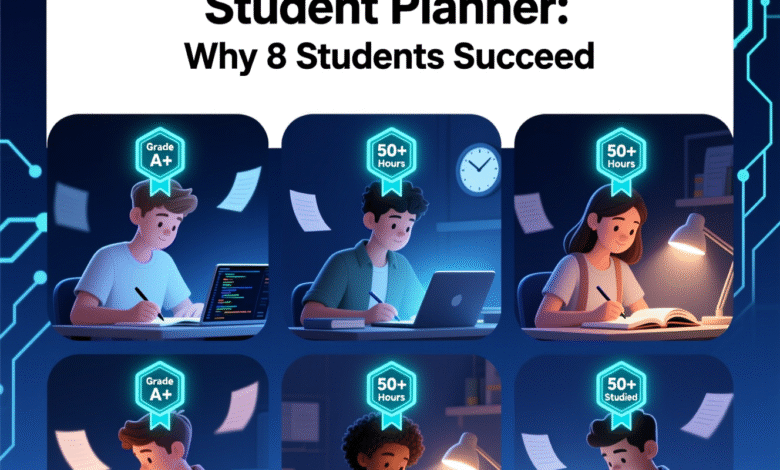
Picture this: It’s 3 AM, you’re halfway through your hospital shift, and tomorrow’s exam weighs heavy on your mind. Your eyes burn, your feet ache, and that textbook at home feels like it’s on another planet. You’re not alone. Every night, thousands of students punch in for overnight shifts while juggling coursework that seems designed for people who sleep when it’s dark. But what if eight students just like you found a way to not just survive, but thrive? They did—and it started when they decided to download night shift student planner tools that actually understood their reality.
The Night Shift Student Struggle: Why Traditional Planning Fails
Understanding Your Unique Challenges
Your body operates on a completely different schedule than the traditional academic world expects. When your classmates are settling into morning lectures, you’re fighting to keep your eyes open after a 12-hour shift. The challenges you face go far beyond simple time management.
Research from the National Sleep Foundation reveals that night shift workers experience up to 40% more difficulty with memory retention and focus compared to their day-shift counterparts. Your circadian rhythm—that internal clock that regulates alertness—gets thrown into chaos when you work against natural light patterns. This isn’t a personal failing; it’s biology.
Beyond the physical challenges, you face:
- Social isolation from study groups that meet during your sleep hours
- Limited access to professors during office hours
- Campus resources that close before your “day” begins
- The constant juggle between earning money and earning grades
Academic institutions rarely accommodate these realities. They schedule mandatory sessions during your recovery time and expect participation in activities designed for traditional students.
The Cost of Poor Planning
The numbers tell a sobering story. Night shift students maintain an average GPA that’s 0.5 points lower than traditional students, according to Department of Education statistics. This gap isn’t about intelligence or dedication—it’s about having the wrong tools for an unconventional schedule.
Consider the financial impact. Every failed course means additional tuition costs, extended graduation timelines, and delayed career advancement. Healthcare workers pursuing advanced degrees while working nights face particularly steep challenges, with dropout rates 35% higher than their day-shift peers.
Poor schedule management creates a cascade of problems:
- Chronic sleep deprivation affecting both work and study performance
- Increased stress leading to physical and mental health issues
- Strained relationships due to constant exhaustion
- Mounting student loan debt without degree completion
The solution isn’t working harder—you’re already pushing limits. The answer lies in working smarter with tools designed specifically for your reality.
Meet the 8 Students Who Cracked the Code
These eight students transformed their academic trajectories by abandoning generic planning methods. Each discovered that success required a fundamental shift in approach—starting with the decision to download night shift student planner templates built for their unique needs.
Student Success Stories
| Student | Profession | Shift Pattern | Program | GPA Before | GPA After | Key Success Factor |
|---|---|---|---|---|---|---|
| Sarah M. | ICU Nurse | 7PM-7AM x3/week | BSN to MSN | 2.8 | 3.7 | Energy-based scheduling |
| Marcus J. | Security | 11PM-7AM x5/week | Computer Science | 2.5 | 3.4 | Micro-study sessions |
| Elena R. | EMT | Rotating 24hr | Pre-Med | 3.0 | 3.8 | Spaced repetition |
| James T. | Warehouse | 10PM-6AM x4/week | Business Admin | 2.3 | 3.2 | Digital integration |
| Aisha K. | Hotel Desk | 11PM-7AM x4/week | Psychology | 2.9 | 3.6 | Sleep protection |
| David L. | Manufacturing | 6PM-6AM x3/week | Engineering | 2.7 | 3.5 | Weekend batching |
| Maria G. | ER Tech | Rotating nights | Nursing | 3.1 | 3.9 | Collaborative planning |
| Robert H. | IT Support | 8PM-4AM x5/week | Cybersecurity | 2.6 | 3.4 | Automated scheduling |
Common Patterns Among Successful Night Shift Students
Analyzing these success stories reveals consistent patterns. Every student started their transformation the same way—recognizing that traditional planning methods were failing them and seeking specialized solutions.
Key patterns that emerged:
- All began by tracking energy levels, not just available time
- Customization proved essential—no two schedules looked identical
- Technology integration saved 5-10 hours weekly through automation
- Community support accelerated progress significantly
- Small, consistent actions trumped marathon study sessions
Sarah, the ICU nurse who raised her GPA by nearly a full point, puts it simply: “I stopped trying to be a day student who happened to work nights. Once I embraced my schedule and found tools that worked with it, everything changed.”
Essential Features to Look for When You Download Night Shift Student Planner
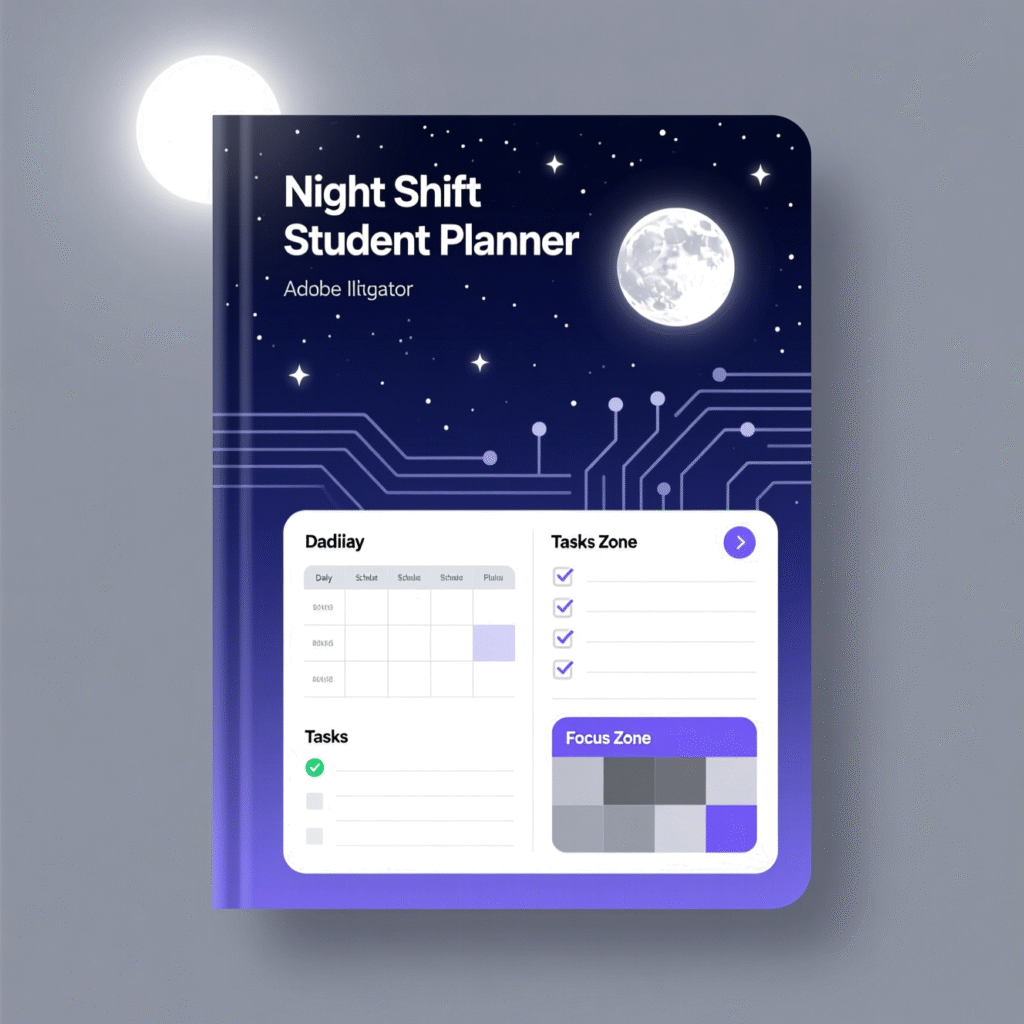
Not all planners are created equal. Your unique situation demands specific features that address the realities of shift work combined with academic pursuits. Here’s what separates effective night shift planners from generic alternatives.
Must-Have Components
- Shift Pattern Recognition
Your planner must understand that your Tuesday might start at 11 PM on Monday. Look for templates with rotating schedule libraries, overtime accommodation features, and pattern recognition for common healthcare, security, and service industry rotations. - Energy Management Tools
Time isn’t your only resource—energy is equally precious. Essential features include hourly energy tracking grids, task-energy matching matrices, and fatigue prediction based on your shift patterns. Some advanced planners even suggest optimal nap timing. - Study Session Flexibility
Rigid 2-hour study blocks don’t work when you’re stealing moments between rounds or during break room downtime. You need variable block lengths from 15-90 minutes, micro-session planning capabilities, and smart break optimization. - Sleep Protection Features
Your planner should guard your sleep like a fierce protector. This means blackout scheduling that prevents any activities during designated sleep times, recovery time calculations based on shift intensity, and sleep debt tracking to prevent dangerous accumulation.
Platform Comparison Guide
| Platform Type | Best For | Pros | Cons | Download Options |
|---|---|---|---|---|
| Google Sheets | Beginners | Free, cloud-based, accessible anywhere | Limited automation features | Templates gallery |
| Excel | Power users | Advanced formulas, offline access | Requires software purchase | Microsoft store |
| PDF Printables | Minimal tech | No battery needed, tangible | Manual updates only | Free websites |
| Notion | Tech-savvy | Database features, infinite customization | Steep learning curve | Template market |
| Apps | Mobile-first | Push notifications, widgets | Often require subscriptions | App stores |
Step-by-Step Guide: How to Download Night Shift Student Planner
Ready to transform your academic journey? Follow this detailed guide to find, download, and implement the perfect planning system for your night shift lifestyle.
Pre-Download Preparation Checklist
Before you download anything, invest 15 minutes in preparation. This groundwork ensures you select the right tool and set yourself up for success:
- Assess your shift pattern complexity – Do you work straight nights, rotating shifts, or irregular on-call schedules?
- Identify device preferences – Will you primarily use a phone, tablet, or computer?
- Determine collaboration needs – Do you need to share schedules with family or study partners?
- Set budget parameters – Are you looking for free options or willing to invest in premium features?
- Evaluate technical skill level – Be honest about your comfort with technology to avoid frustration
The Download Process
Finding Reliable Sources
Your search for quality templates should start with trusted sources. University resource centers often provide free downloads specifically designed for non-traditional students. Check your school’s student success center or library website first.
Online communities offer peer-tested options. Reddit’s productivity and night shift communities regularly share templates that members have refined through real-world use. Professional organizations in nursing, healthcare, and other shift-based fields frequently provide specialized resources for their student members.
Avoid random download sites that might contain malware or poorly designed templates. Stick to verified sources with user reviews and clear documentation.
Installation Steps
- Navigate to your chosen platform using a secure internet connection
- Select the appropriate template based on your earlier assessment
- Click the download button and choose your save location
- Save to a dedicated folder named “Academic Planning” for easy access
- Create a backup copy immediately before making any modifications
- Open in compatible software and verify all features work correctly
Initial Setup Tasks (First 48 Hours)
Your first two days determine whether this tool becomes a game-changer or another abandoned attempt. Block out 90 minutes for comprehensive setup:
- Input your work schedule for the next month, including any known overtime
- Transfer all syllabus information, including participation requirements
- Enter every assignment due date with appropriate buffer time
- Map out exam schedules with study period calculations
- Set firm sleep goals and create non-negotiable boundaries
- Configure notification preferences to respect your sleep schedule
Remember Sarah’s advice: “The setup felt tedious, but those 90 minutes saved me hundreds of hours over the semester.”
Success Story Deep Dive: How Sarah Went from 2.8 to 3.7 GPA
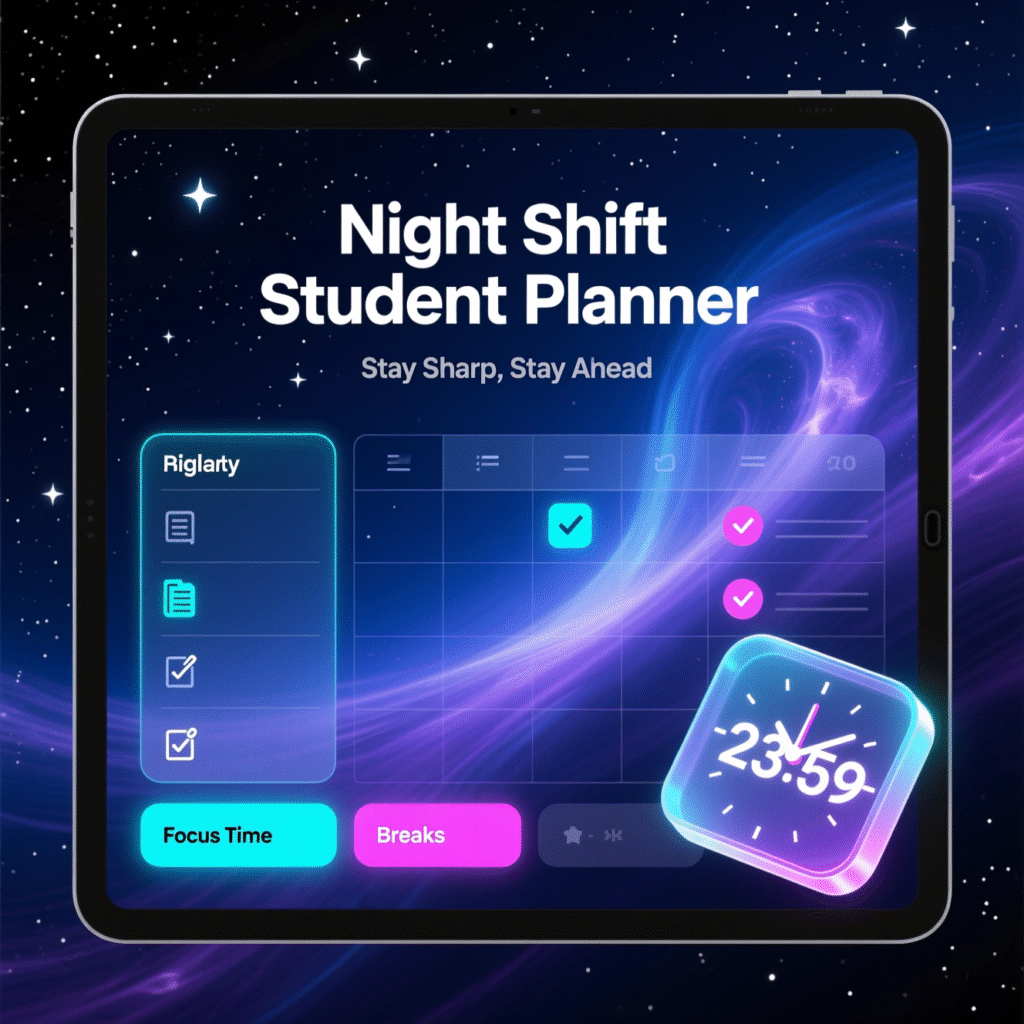
Sarah’s transformation offers a blueprint for your own success. As an ICU nurse working three 12-hour shifts weekly while pursuing her Master’s in Nursing, she faced every challenge you know too well.
Sarah’s Previous Struggles
Before discovering specialized planning tools, Sarah’s academic life was chaos. She’d arrive home at 7:30 AM after managing critical patients all night, force herself to stay awake for an 8 AM online lecture, then crash halfway through. Assignment deadlines seemed to appear from nowhere. Her study method consisted of marathon cramming sessions on days off, leaving her exhausted for her next shift.
“I was drowning,” Sarah recalls. “I’d study for hours but retain nothing. My grades reflected my exhaustion, not my capability.”
The Transformation Process
Week 1-2: Discovery Phase
Sarah’s journey began when she decided to download night shift student planner templates from her university’s nursing resource center. Instead of immediately scheduling study sessions, she spent two weeks tracking her energy levels hourly. She discovered surprising patterns—her sharpest mental state occurred at 4 PM before shifts, not in the morning after work.
Week 3-4: Implementation
Armed with energy data, Sarah rebuilt her entire approach:
- Created 25-minute micro-study templates for hospital break rooms
- Scheduled complex material during pre-shift peak hours
- Moved passive activities like lecture recordings to low-energy times
- Set up automated reminders that respected her sleep schedule
Month 2-3: Optimization
As patterns solidified, Sarah fine-tuned her system:
- Integrated spaced repetition for pharmacology memorization
- Built accountability partnerships with two other night shift nurses
- Created “emergency protocols” for unexpected overtime shifts
- Developed a reward system for consistent adherence
Quantifiable Results
The numbers tell the story:
- Study time reduced by 25% while retention increased by 40%
- Assignment submissions went from frequently late to consistently early
- Sleep improved from 4-5 hours to 7-8 hours daily
- Stress levels, measured by her wellness app, decreased by 35%
- GPA rose from 2.8 to 3.7 over two semesters
Most importantly, Sarah reports feeling in control rather than constantly behind. “I’m the same person working the same shifts. The only difference is how I plan.”
Customization Strategies That Make the Difference
Your downloaded planner is a starting point, not a final destination. The eight successful students all emphasized that customization transformed generic templates into powerful personal tools.
Adapting Templates for Different Shift Patterns
Straight Nights (5 nights/week)
If you work consistent overnight shifts, your customization should focus on routine optimization. Marcus, the security guard, built his entire system around predictable energy patterns:
- Fixed study windows at 3 PM daily before work
- Routine-based triggers (coffee = flashcard time)
- Weekend intensive sessions for major projects
- Meal prep Sundays including study snacks
Rotating Shifts (Days/Evenings/Nights)
Elena’s EMT schedule changed weekly, requiring maximum flexibility:
- Created three template weeks (days/evenings/nights)
- Built pattern-based schedules that auto-adjusted
- Added transition day buffers between shift changes
- Used cloud storage for access across locations
On-Call/Irregular Schedules
James managed warehouse operations with unpredictable overtime. His approach:
- Set minimum daily goals achievable in 30 minutes
- Created portable study kits for unexpected downtime
- Embraced digital everything for instant access
- Built “recovery protocols” for disrupted weeks
Energy Optimization Techniques
Your energy is a finite resource that fluctuates predictably. Track it, protect it, and align your activities accordingly:
- Map your circadian rhythm over 2 weeks using hourly ratings
- Identify “golden hours” where complex tasks feel manageable
- Schedule review during moderate energy to preserve peak times
- Protect lowest energy for rest, not guilty procrastination
- Build in flexibility for the 20% of time when patterns break
Aisha discovered her golden hours occurred split across her day—one hour at 2 PM and another at 2 AM during her hotel shift. She structured her psychology coursework to maximize these windows, tackling theories in the afternoon and case studies during her night peak.
Digital Tools and Integrations
Technology can multiply your efficiency when properly integrated. The successful students leveraged combinations of tools that worked together seamlessly.
Essential App Combinations
Your planning system should connect with tools you already use:
- Calendar Integration: Sync your planner with Google Calendar or Outlook to prevent double-booking
- Note-Taking Apps: Connect to Notion, Evernote, or OneNote for quick capture during shifts
- Time Tracking: Use Toggl or RescueTime to verify your energy patterns
- Focus Tools: Implement Forest or Pomodone for distraction-free study blocks
- Cloud Storage: Ensure everything backs up to Google Drive or Dropbox automatically
Maria’s collaborative approach included shared Google Drives with study partners, allowing real-time updates and mutual support even when schedules never aligned for in-person meetings.
Automation Opportunities
Every minute you save through automation is a minute for sleep or study:
- Schedule imports from work systems eliminate manual entry
- Assignment deadline notifications prevent surprises
- Study session scheduling based on shift endings
- Progress tracking dashboards show trends at a glance
- Weekly report generation for accountability partners
Robert automated 80% of his planning process, spending just 20 minutes weekly on manual adjustments. This efficiency gain alone added 5 hours to his available study time.
- Healthy Lifestyle for Night-Shift Students: 7 Keys to Long-Term Success
- How to Optimize Your Sleep Schedule as a Night-Shift Student in 2025
- Optimize Your Night-Shift Studies with This AI Planner
Common Pitfalls and How to Avoid Them
Learning from others’ mistakes accelerates your success. These five pitfalls derailed many night shift students before they found their rhythm.
The Top 5 Mistakes Night Shift Students Make
- Over-scheduling post-shift time
You arrive home exhausted, yet your planner shows a 2-hour study block. This creates a failure cycle. Start with just 20-minute sessions post-shift, focusing on light review rather than new material. - Ignoring energy patterns
Time availability doesn’t equal cognitive capacity. Track your energy honestly for two weeks minimum before building your schedule. You might discover, like David, that your best study time is 5 AM—right before your shift ends. - Forcing traditional study methods
Three-hour library sessions work for traditional students, not you. Embrace micro-learning through apps, audio reviews during commutes, and digital flashcards during breaks. - Neglecting sleep for study
Sleep deprivation sabotages both work performance and learning. Set non-negotiable minimums—most students need 7 hours within each 24-hour period, regardless of when it occurs. - Going solo without support
Isolation breeds failure. Find accountability partners facing similar challenges. Join online communities where 3 AM study sessions are normal, not weird.
Recovery Strategies When You Fall Behind
Life happens. Overtime becomes mandatory. Family emergencies arise. Your planning system should include protocols for getting back on track:
- Don’t abandon the system entirely—reduce complexity instead
- Focus on highest-impact tasks that directly affect grades
- Use catch-up weekends strategically, batching similar activities
- Communicate with instructors early about shift-related challenges
- Implement “minimum viable” days where any progress counts
Remember: perfection isn’t the goal. Consistency despite imperfection creates success.
Building Your Support Network
Success in night shift studying rarely happens in isolation. The eight students all emphasized how crucial community support became to their achievement.
Online Communities for Night Shift Students
Your tribe exists—you just need to find them:
- Reddit Communities: r/NightShift has 150k+ members sharing experiences. r/StudentNurse and r/GetStudying offer academic-specific support
- Facebook Groups: Search “Night Shift Students United” or program-specific groups like “Night Shift Nursing Students”
- Discord Servers: 24/7 study rooms where someone’s always awake and studying
- WhatsApp Groups: Create local networks with classmates in similar situations
These communities provide more than sympathy. Members share templates, study techniques, and real-time motivation during those brutal 3 AM study sessions.
Creating Accountability Systems
Partner Matching Criteria
Your ideal accountability partner shares:
- Similar shift patterns (or at least understands yours)
- Complementary study goals (mutual support without competition)
- Compatible communication styles (text vs. voice preferences)
- Equal commitment levels (both serious about success)
Weekly Check-in Template
Every Sunday, Maria and her partners spent 20 minutes on video chat following this structure:
- Share completed goals from the previous week
- Discuss challenges faced without judgment
- Plan upcoming week with mutual input
- Celebrate wins together, no matter how small
- Adjust strategies based on what’s working
This simple routine kept all three partners on track through graduation.
Measuring Your Success
Progress tracking prevents you from feeling like you’re spinning wheels. These metrics matter more than hours logged.
Key Performance Indicators (KPIs) for Night Shift Students
| Timeframe | Metrics to Track | Target Improvement | How to Measure |
|---|---|---|---|
| Week 1-2 | Session completion rate | 70% | Planner checkoffs |
| Month 1 | Energy-task alignment | 80% match | Self-rating scale |
| Month 2 | Grade improvements | 0.3 GPA increase | Official transcripts |
| Semester | Sleep quality | 7+ hours/day | Sleep tracker app |
| Year | Graduation progress | On track | Credit completion rate |
Adjustment Protocols
Weekly reviews prevent small issues from becoming major problems. Every Sunday, spend 15 minutes assessing:
- What worked well (celebrate these wins!)
- What needs improvement (without self-judgment)
- Energy pattern changes (shift work affects rhythms)
- Schedule modifications needed (upcoming challenges)
- Support requirements (when to ask for help)
Elena’s weekly reviews revealed that her energy patterns shifted with the seasons. She adjusted her study schedule accordingly, maintaining consistent performance despite biological changes.
Advanced Strategies from Our 8 Success Stories
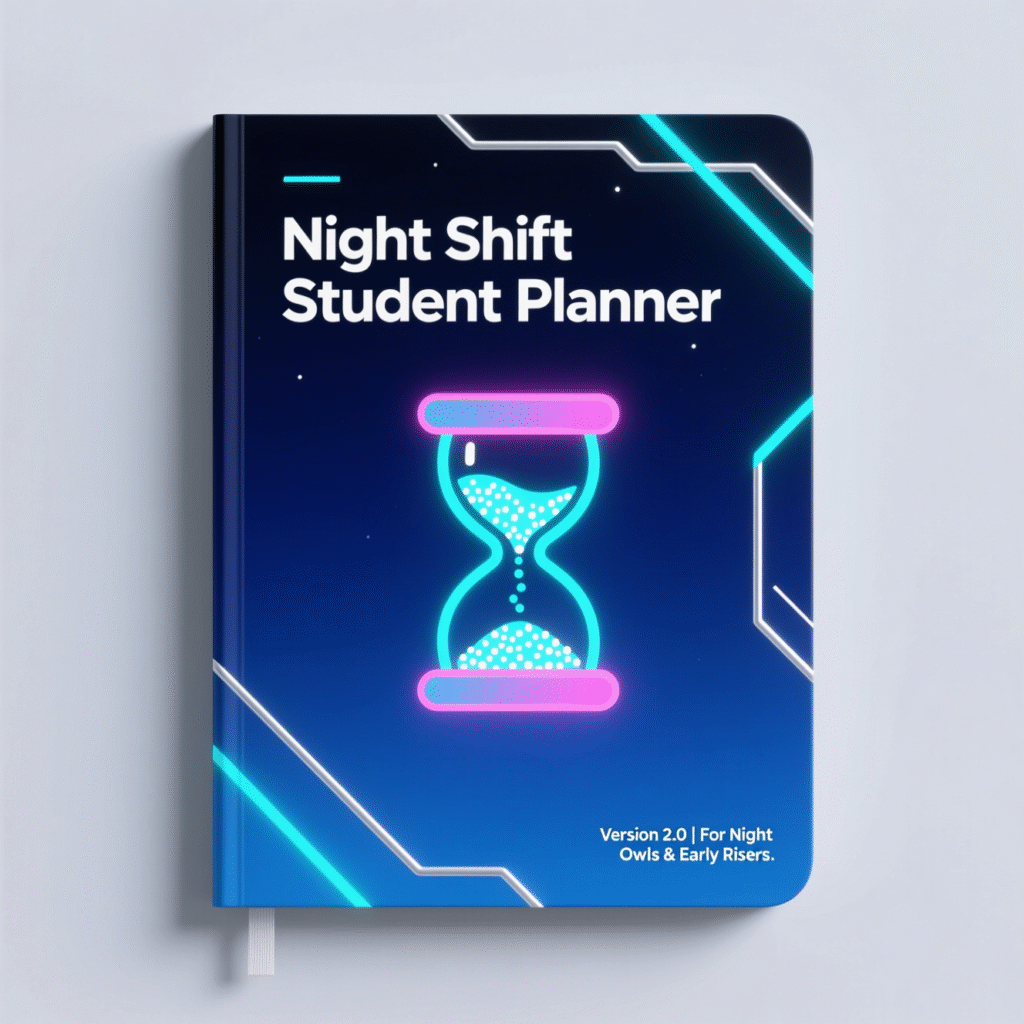
Each successful student developed unique approaches worth adopting. Here are three proven methods you can implement immediately.
The Power Hour Method (Marcus’s Technique)
Marcus identified one golden hour daily where his focus peaked. He protected this time fiercely:
- Identify your single best hour through two weeks of tracking
- Eliminate all distractions during this time—phone off, notifications disabled
- Focus on your hardest subject when your brain performs best
- Take no breaks during this power hour
- Track progress religiously to see compound gains
This single hour often accomplished more than three hours of unfocused effort.
The Weekend Warrior Approach (David’s Strategy)
David’s manufacturing schedule left him drained on workdays. His solution:
- Set minimal weekday goals (30 minutes maximum)
- Block out entire weekend days for intensive study
- Meal prep all study day food in advance
- Implement social media blackouts Friday night through Sunday
- Build in rewards for completed weekend sessions
This approach honors your body’s needs while ensuring progress continues.
Collaborative Cloud Method (Maria’s System)
Maria leveraged technology to create virtual study partnerships:
- Shared Google Drive with all course materials
- Collaborative calendars showing everyone’s availability
- Group chat platform for quick questions
- Virtual study rooms via Zoom or Discord
- Progress tracking sheets visible to all members
Despite never meeting in person, Maria’s group provided stronger support than traditional study partners.
FAQ Section
Frequently Asked Questions About Download Night Shift Student Planner
Q: Where can I download night shift student planner templates for free?
You can download night shift student planner templates from several reliable sources. Start with your university’s resource center or library website—many schools offer free templates designed for non-traditional students. Google Sheets template gallery includes several night shift options. Reddit communities like r/NightShift and r/GetStudying regularly share member-created templates. Professional organizations in nursing, healthcare, and other shift-based fields often provide free resources for student members.
Q: Will a downloaded night shift student planner work with rotating schedules?
Yes, quality templates accommodate rotating schedules through pattern recognition features. When you download night shift student planner templates designed for healthcare or service industries, they typically include rotation libraries. You input your pattern once (like 2 days, 2 evenings, 2 nights, 2 off), and the template automatically populates future weeks. Look for templates with “rotation-friendly” or “shift pattern” in their descriptions.
Q: How long before I see results after I download night shift student planner tools?
Based on our eight success stories, results appear quickly with consistent use. Students report improved organization within the first week—suddenly knowing exactly when assignments are due and when to work on them. Energy management improvements surface by week two as you align tasks with natural rhythms. Grade improvements typically manifest within 4-6 weeks, with the most dramatic changes occurring after one full semester of consistent use.
Q: Can I download night shift student planner templates on my phone?
Absolutely. Most modern templates are mobile-optimized. Google Sheets templates work seamlessly through the free mobile app. Excel templates function via Microsoft’s mobile apps. PDF planners can be viewed and annotated using apps like Adobe Reader or GoodNotes. For the best mobile experience, look specifically for “mobile-friendly” or “responsive” templates when you download night shift student planner resources.
Q: What’s the difference between free and paid planners I can download?
Free planners provide essential features: schedule templates, time blocking, and basic customization. They’re perfect for students starting their planning journey. Paid versions (typically $10-30) add automation features, advanced analytics, premium templates, and ongoing updates. Our eight successful students started with free versions. Three eventually upgraded to paid options as their needs grew more complex. Start free, then invest if you find planning transforms your academic performance.
Conclusion: Your Success Story Starts Now
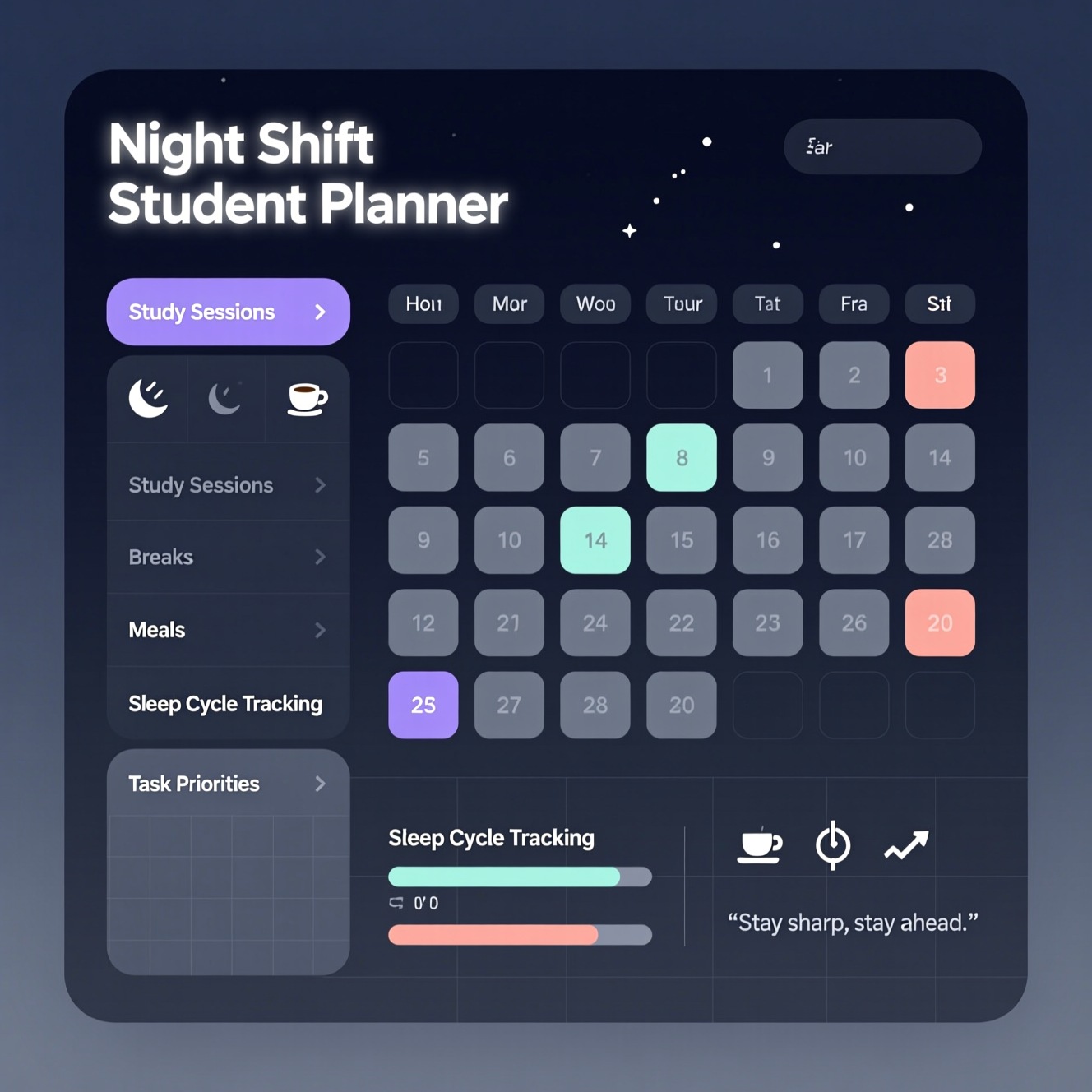
The eight students featured in this article were once exactly where you are—exhausted, overwhelmed, and wondering if balancing night shifts with education was even possible. What changed everything wasn’t working harder or sleeping less. It was finding and implementing the right tools. When Sarah decided to download night shift student planner templates designed for her ICU schedule, she didn’t just improve her grades—she transformed her entire approach to learning.
Your journey doesn’t have to be a constant struggle against time and fatigue. The resources exist, the systems work, and the proof lives in these eight success stories. Every one of them started with a simple decision: to stop forcing themselves into traditional planning methods and embrace tools built for their reality.
Take Action Today:
- Choose one planner format that resonates with you
- Download your selected template right now
- Spend 30 minutes on initial setup
- Commit to one week of consistent use
- Share your progress with our community
Remember: you’re not just a student who happens to work nights. You’re a dedicated professional investing in your future while serving others. You deserve tools that honor that commitment and amplify your efforts.
The path from struggling night shift student to academic success story is shorter than you think. It starts with a download, continues with customization, and culminates in the achievement of goals you might have thought impossible.
Join Sarah, Marcus, Elena, and the others who proved that night shifts and academic excellence aren’t mutually exclusive. Download your night shift student planner today and become success story number nine.
Your transformation is one download away. Which success strategy will you try first? Share your experience in the comments below and inspire the next night shift student to reach for their dreams.



